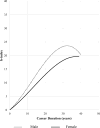Gender Differences in Publication Productivity Among Academic Urologists in the United States
- PMID: 28232174
- PMCID: PMC5532805
- DOI: 10.1016/j.urology.2016.12.064
Gender Differences in Publication Productivity Among Academic Urologists in the United States
Abstract
Objective: To describe the publication productivity of academic urologists in the United States by gender.
Materials and methods: Gender inequality is prevalent in most surgical subspecialties, including urology. Despite small numbers of women in academic positions, differences in scholarly impact by gender are relatively unknown. We assembled a list of 1922 academic urologists (1686 men (87.7%), 236 women (12.3%)) at 124 academic institutions throughout the United States as of February 2016. Scopus and Google Scholar were queried for bibliometric data on each individual, including h-index and m-quotient. We analyzed these metrics for both genders by educational background, subspecialty, National Institutes of Health funding, and academic rank.
Results: Men had higher median h-indices than women overall (P < .05), and had higher successive academic ranks (P < .05). Proportionally fewer women attained senior academic ranking (professor/chair), (P < .05). There was no difference in research productivity by successive rank after controlling for career duration (m-quotient). Women were more likely to choose a practice that specialized in pediatric urology or female urology/pelvic reconstructive surgery than their male counterparts (P < .05).
Conclusion: Women represent a growing proportion of academic urology faculty, but despite the recent increase in number entering the field, relatively few women occupy senior leadership positions. Improving psychosocial barriers to advancement such as lack of mentorship or discriminatory policies may help pioneering female urologists as they progress in their careers.
Copyright © 2017. Published by Elsevier Inc.
Figures



Comment in
-
Editorial Comment.Urology. 2017 May;103:45-46. doi: 10.1016/j.urology.2016.12.065. Epub 2017 Mar 10. Urology. 2017. PMID: 28285818 No abstract available.
References
-
- Kim SJ, Hyun G. MP15-04 WOMEN IN UROLOGY: TIME TO LEAN IN. The Journal of urology. 191:e145.
-
- Monga M. The State of the Urology Workforce and Practice in the United States 2015. In: Clemens Q, editor. American Urological Association Annual Meeting. San Diego, CA: American Urological Association (AUA); 2016.
-
- Zhuge Y, Kaufman J, Simeone DM, Chen H, Velazquez OC. Is there still a glass ceiling for women in academic surgery? Annals of surgery. 2011;253:637–643. - PubMed
-
- Reed DA, Enders F, Lindor R, McClees M, Lindor KD. Gender differences in academic productivity and leadership appointments of physicians throughout academic careers. Academic medicine : journal of the Association of American Medical Colleges. 2011;86:43–47. - PubMed
-
- Nonnemaker L. Women Physicians in Academic Medicine — New Insights from Cohort Studies. New England Journal of Medicine. 2000;342:399–405. - PubMed
MeSH terms
Grants and funding
LinkOut - more resources
Full Text Sources
Other Literature Sources

